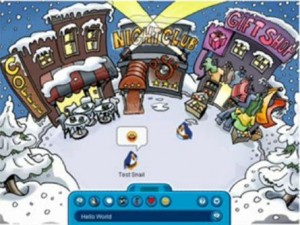Here is One Laptop Per Child* according to American media: One Laptop Per Child on 60 Minutes – Thanks for the “cadre of geeks” comments, Lesley, really selling the idea of digital literacy :-S
*Terms and conditions apply: for residents of the United States and Canada, just holding one of these green-and-white computer will stigmatize you, your family and reflect poorly on your school. Other children will have something fancier, be able to do more things on their portable devices and look cool while doing it. Besides, who uses laptops anymore? It is an unfortunate thing that this otherwise noble and egalitarian operating system will face its greatest challenge in the free market nearly cornered by Apple iPads (which unlike the OLPC, are less durable and will eventually be obsolete in four years). The OLCP website contains mostly photo images with brief, caption-sized stories about what they can do, how they are a boon to under-privileged children in hard-luck schools. There are hyperlinks to blog posts, and for the Walmart shoppers news of the XO Tablet appears to top the list. It is an engine for social justice, and this is perhaps its biggest drawback for countries still promoting the American dream, something affordable and “ambitious” as the OLPC gets looked down upon: proof that not enough dreamers are living up to the nation’s potential of becoming rockstar presidents (or in Canada, I dunno, an athlete who gets traded to an American team?). This is the main reason why the digital divide persists.
With the small print out of the way, I admire the innovation and simplicity of design the One Laptop represents. Along the same humanitarian reach of Hole in the Wall and other programs to increase computer exposure to children. Their website lets the pictures do the talking, great for children seeking the inspiration to get connected. The 60 Minutes video does a soft sell of its potential to at least level the playing field in countries where poverty, lack of infrastructure and challenging climate conditions pose a threat to average computers. One of the most intriguing aspects of these laptops is the button that let’s the child see the code for any of the screens they are looking at, enabling children to explore and experiment with the behind-the-curtain aspects of computing. On the OLPC wiki, there is a page on constructionism, citing a few familiar theorists (otherwise known as constructist like Piaget, Vygotsky and Papiert) and the belief that children working together will create social change. Of course, leave it to the adults to mess things up, as 60 Minutes close their report (or at least this segment) on Intel’s attempt to undercut OLPC’s altruism, but perhaps with more netizens worldwide, The Man will have less of a deterimental effect on digital connectivity.
One way to measure the level of success is to hear from the children themselves, rather than the designers and educators speak its praises: here is one child in Bhutan answering his teacher’s questions, but it won’t be long before they are demonstrating their own ideas. I like that LEGO and Stratch have teamed up with the One Laptop, and look forward to seeing more from around the world.

